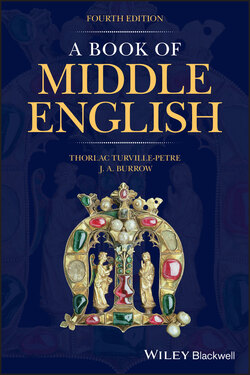Читать книгу A Book of Middle English - J. A. Burrow - Страница 18
2 Pronouncing Middle English 2.1 Introduction
ОглавлениеAlthough the scribes who copied our texts wrote Middle English in a variety of differing forms, their spelling generally keeps closer to the sounds of words than does that of Modern English. Modern English spelling, largely fixed by the usage of early printers, has in many words preserved letters which no longer correspond to anything in the changed spoken language – as in ‘knight’, for instance. Middle English spelling, being more fluid, was better able to adapt to changes in pronunciation as they occurred. None of the spelling systems represented in this book can be called ‘phonetic’, in the sense of having one and only one written symbol for each sound; but there are relatively few words in which a letter (like k in modern ‘knight’) has no corresponding sound in the spoken form.
It is always desirable to have some idea of how poetry should sound; but in the case of Middle English writings – prose as well as verse – there are particular reasons for trying to hear as well as see them. In an age when written copies were still relatively scarce, texts were often transmitted by reading them aloud to a listener or group: in his Troilus, Chaucer describes Criseyde sitting with two other ladies in her parlour listening to a maiden reading aloud from a book (17/81–4). Even solitary readers commonly murmured as they read. The kind of speed‐reading which leaps straight from the printed form of a word to its meaning was rarely possible in an age of manuscript, where handwritings and spellings varied from copy to copy. Hence medieval texts make bold use of effects designed to strike the ear – rhymes, alliterations, rhythmical parallels, and the like.
What follows is no more than a rough guide, to enable readers to produce or imagine approximately the right sounds. These are indicated between slashes (/ /). Where modern equivalents are given, these are drawn from standard British English (RP, ‘Received Pronunciation’). For fuller accounts of Middle English phonology, see Blake (1992) and Jordan in Bibliography 9.2 below.
